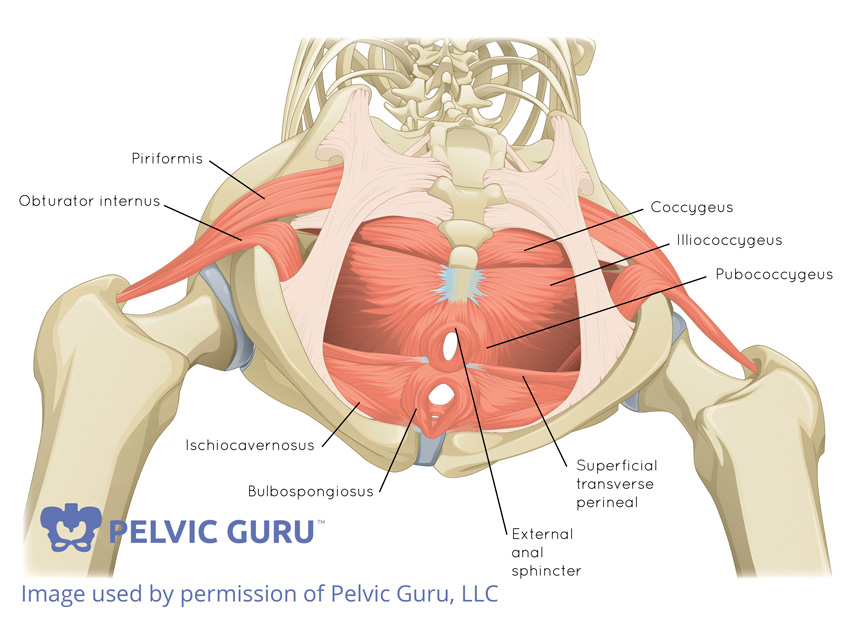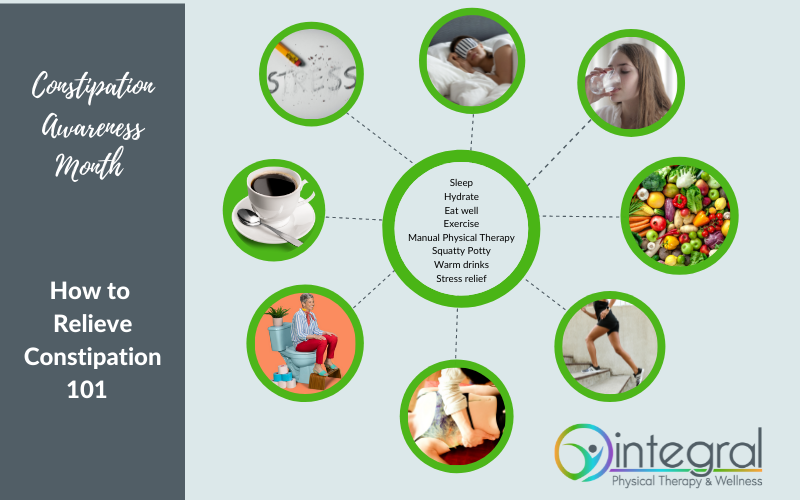If you are like many men and women, you may be suffering from pelvic floor dysfunction (PFD), also known as pelvic floor muscle dysfunction (PFMD). It’s actually quite common, affecting more than half of the population. But, it’s not easy for many people to associate symptoms they may have in their pelvis, hips, or low back with pelvic floor dysfunction because it is not as obvious as other muscular issues.
What Is Pelvic Floor Dysfunction?
Let’s start with what the pelvic floor is. It is a sling of muscles at the base of the pelvis. Everyone has a pelvic floor. It is very similar in men and women, and ultimately, these muscles are like any other muscle in the body. Their main roles are to:
- Maintain continence (hold in urine, stool, and gas when necessary)
- Support the pelvic organs: bladder, rectum, uterus and vagina (in women), and prostate (in men)
- Stabilize the pelvis and spine
- Assist with sexual arousal
- Help maintain proper intraabdominal pressure

Pelvic floor dysfunction is a common condition where you’re unable to correctly relax and coordinate the muscles in your pelvic floor. When this group of muscles is affected, they often hold too much tension. This is similar to feeling stress or tension in the upper shoulder or neck muscles. When the muscles are overactive, the result can be restricted movement, misalignment of the joints, bladder and bowel issues, impaired sexual function, and/or pain.
What Are the Symptoms of Pelvic Floor Dysfunction and How Do You Know You Have It?
Although many may not realize that the pelvic floor muscles have a problem, there are some telltale signs or symptoms that may indicate you have pelvic floor dysfunction. These include:
- Feeling the need to urinate frequently
- Constipation and/or frequent straining during a bowel movement
- Painful urination
- Leaking stool or urine
- Feeling pain in your lower back, hips, abdomen, and/or pelvic region
- Painful sex
- Inability to have an orgasm
- Painful periods in women
- Pelvic Organ Prolapse in women
- Erectile dysfunction in men
- Symptoms of prostatitis in men
- Symptoms of bladder infection or recurrent bladder infection in women
How Do You Treat Pelvic Floor Dysfunction With Physical Therapy?
The good news is that pelvic floor dysfunction is usually treatable with physical therapy. In fact, it is considered to be a first-line treatment for the condition.
Pelvic floor physical therapy can help patients with relieving the symptoms of pelvic floor dysfunction by working, stretching, and relaxing those muscles to help them work the way they should. This article describes what you can expect in pelvic floor physical therapy.

It is very important to know that pelvic floor physical therapy is not ONLY about the pelvic floor. It’s about how the pelvic floor muscles interact with the rest of the body. This means that we assess the mobility of the spine, pelvis and hips, your strength, your flexibility, your coordination, your balance, your posture, and your mental health. All of these things play a role in your body’s ability to perform the tasks that you ask of it. We even assess from the foot to the neck because everything is connected, and anything can affect how the pelvis is functioning. A foot injury can trigger pelvic floor tension or a new onset of urinary leakage, and jaw and neck tension are associated with pelvic floor tension. A comprehensive assessment is important to your ultimate success.
During your first visit, we take measurements and assess all of these different areas. If deemed necessary, which it often is, we may recommend an internal pelvic floor evaluation. This involves the physical therapist directly assessing the pelvic floor muscles either intravaginally or intrarectally. Don’t worry, there’s no speculum or other tools involved. We use a gloved index finger to assess the strength, tension, and overall integrity of the pelvic floor muscles. This is never mandatory, but it is the best way for your practitioner to get the most information about your muscles. This does not take place every treatment session but may be performed periodically to determine your progress.
Physical Therapy Treatment for PFD
Again, the pelvic floor muscles are exactly that: muscles. This means that they have to be treated like any other muscle in the body. If they are weak, we strengthen them. If they have too much tension, we perform stretches. If they are painful, massage or soft tissue mobilization may be necessary, internally or externally. Finding the source of dysfunction is necessary to prevent recurrence of your issues. As we restore the health of the muscles, we retrain the coordination of the muscles with the rest of your core and overall movement patterns in order to get your body functioning well.
Treatments vary according to the issues present, but the following may be included in accordance with a treatment plan created together with the therapist and patient:
- Manual therapy: internal and/or external soft tissue release, trigger point release, visceral mobilization, myofascial release
- Breathing retraining
- Education on and retraining of bowel and bladder habits
- Pelvic floor muscle relaxation and/or strengthening
- Core strengthening
- Training in coordination of the pelvic floor muscles with other muscle groups
- Joint mobility in the spine, pelvis, and hips
- Assessment of other areas possibly contributing to pelvic issues
- Postural retraining
- General strengthening
- Sport-specific training
- Pain management and pain science education
Pelvic Floor Dysfunction Physical Therapy Treatment Is Available in East Cobb, Marietta, Sandy Springs, and Roswell
Integral Physical Therapy is located in the heart of East Cobb, minutes from downtown Marietta, Sandy Springs, and Roswell.
It is important to remember that not everyone who is a PT can treat this condition. When looking for a PT, make sure to ask questions about their experience with specifically treating pelvic floor dysfunction. The therapists at Integral have taken extensive specialty courses in pelvic health and have considerable clinical experience in treating pelvic floor dysfunction and pelvic health issues in women, men, and children. We can even attest to the success that pelvic floor physical therapy brings. If you are struggling with one or more of these issues, know that life can get better, and it will get better with the help of a pelvic floor PT.
These muscles are incredibly important and have been ignored for far too long in too many people. Many people have been told a narrative that it is normal to leak urine after they have a baby or as they age, that sex may be painful sometimes, that it is normal to have pain during your period, that as you get older you may not be able to become aroused anymore. Or that some people just can’t become aroused or have orgasms. But these are false narratives. Common does not equal normal. Pelvic floor physical therapy can improve the health, strength, and coordination of these muscles so that you can live pain-free, stop leaking, and enjoy sex!
Our goal as pelvic floor physical therapists is to help our clients live the lives they want to live. A personalized approach is most helpful so let’s get you feeling better! Contact us now to schedule an appointment or a free 15-minute phone call to see if our practice is a good fit for you.





